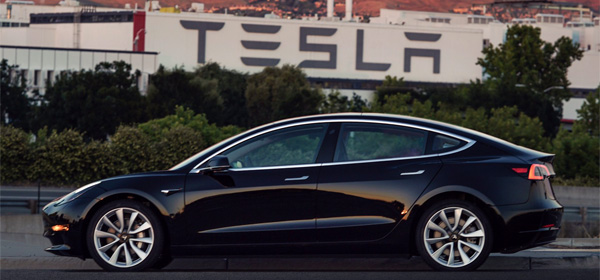The co-founder of electric car-maker Tesla, Elon Musk, released photos of the company’s first mass-produced electric car – the highly anticipated Model 3 – earlier this week.
The Model 3 is Tesla’s cheapest model to date, set to retail for $US35,000 ($A45,700). The Tesla cars currently on the market sell for an average of $US90,000 ($A117,000).
The new, five-seat vehicle will accelerate from 0kmh to 100kmh in just under six seconds, and can travel at least 345km on a single charge.
It also has autopilot capabilities including auto lane-change, smart summon (which brings your car to meet you) and automatic emergency braking.
Last week, Mr Musk noted that 100 Model 3 cars would be produced in August, before increasing to 1500 by September and no less than 20,000 produced a month by December.
Tesla has so far received 400,000 pre-orders for the new car with a delivery schedule set for some time late next year. There will be a further nine-month wait for the right-hand-drive version of the car.
Switching to an electric car not only helps the environment, it can represent a significant saving on fuel and other running costs.
The new Tesla Model 3 is being pitched at the luxury car market, alongside cars such as the BMW 3-Series and the Mercedes Benz C-Class, which sell for around $60,000 locally. That is already a saving of around $15,000 before the costs are broken down.
Assuming you charge your car’s battery overnight when power is at its cheapest (conservatively 12 cents a Kilowatt Hour [kWh]), you can expect to pay about 1.7 cents per kilometre to restore your power pack, or $1.70 per 100km. That is about a quarter of what it would cost to fill up a fuel-driven car. Assuming a petrol price around $1.20 per litre, a modern petrol-based car has fuel costs a lot closer to $9 per 100km.
ABS figures show Australians drive on average 15,000km a year, which represents a saving of over $1000 a year when plugging in instead of filling up.
In terms of maintenance, it is hard to put an exact dollar value on the difference, but because electric cars have fewer moving parts, they are less likely to break down. Service packages should be cheaper, too, because electric cars don’t require oil changes or cooling system flushes. They also considerably less wear on brakes, as the engine is partly responsible for slowing the car.
One drawback of switching to an electric car, however, is replacing a battery. Over time, car batteries degrade, losing around half of their charge after around 10 years. Tesla offers an eight-year limited warranty on batteries, but they can cost as much as $10,000 to replace when out of warranty.
What do you think? Would you consider buying an electric car? At what price would you be likely to make the switch?
Related articles:
Best cars under $30,000
Computers vs cars
Pensioners resort to living in cars

